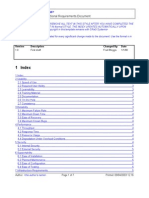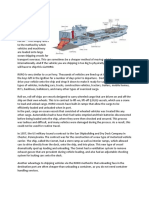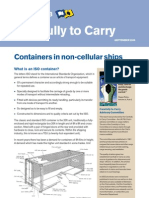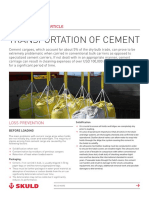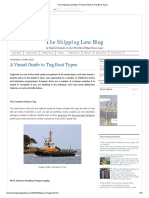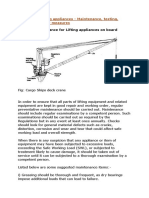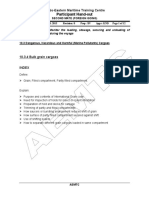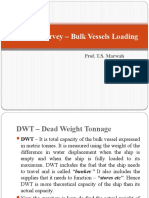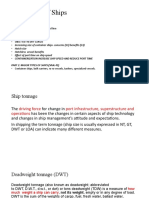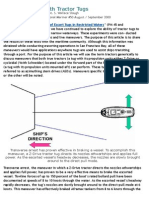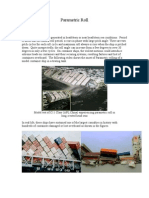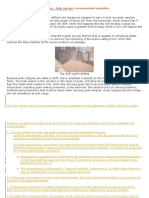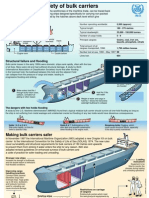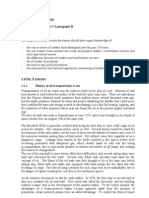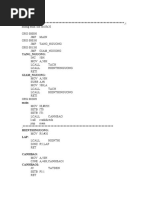Bulk Carriers
Bulk Carriers
Uploaded by
Marco Di PalmaCopyright:
Available Formats
Bulk Carriers
Bulk Carriers
Uploaded by
Marco Di PalmaCopyright
Available Formats
Share this document
Did you find this document useful?
Is this content inappropriate?
Copyright:
Available Formats
Bulk Carriers
Bulk Carriers
Uploaded by
Marco Di PalmaCopyright:
Available Formats
Improving the safety of bulk carriers
Modern bulk carriers, often described as the workhorses of the maritime trade, can be traced back to the 1950s when shipyards began building ships designed specifically for carrying non-packed commodities. Bulk carriers can be identified by the hatches above deck level which give access to the huge cargo holds below.
Number operating worldwide: Typical length: Typical deadweight: Number of cargo holds:
Navigation bridge
Hold No.8 Hold No.7 Hold No.6 Hold No.5
IIM MO O
5,500 (approx) 180 - 275 metres 33,000 - 150,000 tonnes 5-9 Grains, coal, iron ore, bauxite, phosphate, nitrate 1,795 million tonnes
Transverse bulkhead
Hatch
Principal cargoes: Total amount of all cargoes transported, 1996:
Hold No.4
Hold No.3
Hold No.2
Hold No.1
Engine room
Double bottom
Number lost at sea, 1990 May 1997: 99 Lives lost: 654
Structural failure and flooding
Bulk carrier losses in the early 1990s were dramatic: ships sank rapidly, often with the loss of all lives. Many were old and had suffered structural damage. A study by IACS (International Association of Classification Societies) found that after flooding in the foremost hold, the bulkhead between this hold and the adjacent hold can collapse from the pressure of cargo and water, leading to progressive flooding and sinking.
Ship sinks as soon as holds 1 and 2 are flooded
Water enters hold No.1 through faulty hatch cover, collision, corroded hull plating or other reason
3 2
Hold No.2 fills with water
Weight of water and cargo in hold No.1 forces the transverse watertight bulkhead to collapse
The dangers with two holds flooding
A study by the U.S. Maritime Administration (MARAD) found that a typical midsize bulk carrier should survive all one-hold flooding so long as the ship is not suffering from metal wastage and undetected cracks but flooding of any two holds would have disastrous consequences.
Holds 1 & 2 or 2 & 3: Ship sinks rapidly, no time for crew to abandon ship.
Holds 6 & 7: Submergence of the after deck and possible catastrophic down-flooding in the engine room.
Remaining holds: Sagging, which could cause structural failure, especially if the ship is poorly maintained.
Making bulk carriers safer
In November 1997 the International Maritime Organization (IMO) adopted a new Chapter XII on bulk carrier to the International Convention for the Safety of Life at Sea (SOLAS) 1974. The new rules cover survivability and structural requirements for bulk carriers of 150 metres and upwards to prevent them from sinking if water enters the ship for any reason. IMO also adopted revised guidelines on enhanced surveys of bulk carriers and a code of practice for safer loading and unloading.
Stronger new ships Increase the strength of bulkheads and the double bottom to withstand hold-flooded conditions. Improve cargo handling practices Conveyor belts (several kilometres long) often overload ships. Huge grabs (up to 36 tons), bulldozers and hydraulic hammers used for unloading can cause structural damage. Monitoring equipment Equipment to be fitted to monitor the stresses on the ships structure.
GRAPHIC: LIZ GOULD
Existing ships The bulkhead between holds 1 and 2 and the double bottom of hold 1 must be strengthened to withstand flooding in hold 1.
Restrictions on carriage of cargoes Existing bulk carriers which do not meet the new structural requirements will be restricted from carrying high density cargoes and must be marked with a solid equilateral triangle on the hull at midships below the deck line.
Enhanced surveys Enhanced programme of inspections to detect potential structural weakness and areas of corrosion.
You might also like
- Non-Functional Requirements Document Template-1Document7 pagesNon-Functional Requirements Document Template-1praveenjutur100% (1)
- Capt Harun Oral QDocument23 pagesCapt Harun Oral QNyo Thant100% (5)
- Imsbc CodeDocument2 pagesImsbc CodeBBluningningNo ratings yet
- Design Standards For Swimming Pools 1-5-10 PDFDocument41 pagesDesign Standards For Swimming Pools 1-5-10 PDFPratyusha Halder80% (5)
- Wheat Transport & VentilationDocument20 pagesWheat Transport & VentilationAdrian100% (1)
- A Guide To Understanding Ship Weight and Tonnage MeasurementsDocument4 pagesA Guide To Understanding Ship Weight and Tonnage Measurementshendry_hdw100% (2)
- RoroDocument12 pagesRoroPearl NixenNo ratings yet
- Bulk Carriers TypesDocument11 pagesBulk Carriers TypesJeesonAntonyNo ratings yet
- Parametric RollingDocument7 pagesParametric RollingneerajNo ratings yet
- Containers in Non-Cellular ShipsDocument7 pagesContainers in Non-Cellular ShipschildofheavenNo ratings yet
- Session 2 Presentation 5 China Shipping Group Anti PiracyDocument60 pagesSession 2 Presentation 5 China Shipping Group Anti Piracygiannis2100% (1)
- Transportation of CementDocument13 pagesTransportation of CementKaustubh Joshi100% (2)
- Steering Gear1Document31 pagesSteering Gear1Monindika WarshakoonNo ratings yet
- Different Types of TankersDocument10 pagesDifferent Types of TankersNestor HerreraNo ratings yet
- Cargowork 4 Bulk CargoesDocument55 pagesCargowork 4 Bulk CargoesMahami M Prosper100% (1)
- Chemical Tanker: Main Characteristics of Chemical TankersDocument6 pagesChemical Tanker: Main Characteristics of Chemical TankersTri Wahyu PrastiyoNo ratings yet
- The Shipping Law Blog: A Visual Guide To Tug Boat TypesDocument16 pagesThe Shipping Law Blog: A Visual Guide To Tug Boat TypesKevin de ArmasNo ratings yet
- Chemical Tanker Vessel: ClassificationDocument2 pagesChemical Tanker Vessel: ClassificationGimurtu Cristian67% (3)
- Hoegh Osaka MAIB ReportDocument86 pagesHoegh Osaka MAIB ReportIWCPOnlineNo ratings yet
- 5 Ballast SequenceDocument46 pages5 Ballast Sequenceนัทเดช เรืองสวน100% (1)
- Its27 Twin Fin ConceptDocument10 pagesIts27 Twin Fin ConceptmitsosNo ratings yet
- Oxy Acetylene EquipmentDocument2 pagesOxy Acetylene EquipmentCarlos Zamorano100% (1)
- Docking:Undocking & Grounding:StrandingDocument12 pagesDocking:Undocking & Grounding:StrandingAkhil D SNo ratings yet
- Swaroop Sir Ship ManoeuDocument66 pagesSwaroop Sir Ship Manoeuvishal100% (1)
- Parametric Rolling - Container Lashing Systems: March 2002Document1 pageParametric Rolling - Container Lashing Systems: March 2002Dee CeeNo ratings yet
- Deck Cadet SSTP - List of Projects and ActivitiesDocument36 pagesDeck Cadet SSTP - List of Projects and ActivitiesAzim Modak100% (1)
- Here Is All You Wanted To Know About Draft Survey CalculationsDocument43 pagesHere Is All You Wanted To Know About Draft Survey Calculationseduard1960No ratings yet
- ASM Masters Solved Past Question Papers Solved Numericals From Sept16 Till Nov21Document302 pagesASM Masters Solved Past Question Papers Solved Numericals From Sept16 Till Nov21arivarasan100% (1)
- Primary and Secondary Means of Venting On TankersDocument19 pagesPrimary and Secondary Means of Venting On TankersFlexi100% (1)
- PUBS Loss Prevention Gangways - 0719 1Document23 pagesPUBS Loss Prevention Gangways - 0719 1karaflass100% (1)
- Wet Damage On Bulk Carriers: With You at All TimesDocument32 pagesWet Damage On Bulk Carriers: With You at All TimesDerfliw John Valenzuela Gayanoche100% (1)
- Car Carrier Power PointDocument58 pagesCar Carrier Power Pointranjanvats100% (5)
- Cargo Ships Lifting AppliancesDocument35 pagesCargo Ships Lifting AppliancesIshan Vyas50% (2)
- Grain CargoDocument12 pagesGrain CargoBryan almieda100% (1)
- Coal Cargoes PDFDocument3 pagesCoal Cargoes PDFtejmayerNo ratings yet
- 180k Bulk Carrier ReportDocument173 pages180k Bulk Carrier ReportAdrian Gilby100% (1)
- Emergency Towing ArrangementDocument9 pagesEmergency Towing ArrangementManish100% (1)
- Draft Survey - Bulk Vessels LoadingDocument5 pagesDraft Survey - Bulk Vessels LoadingSoubam Luxmibai100% (1)
- A Complete Guide of Bringing A Ship To Dry DockDocument21 pagesA Complete Guide of Bringing A Ship To Dry DockNikolas GonzalezNo ratings yet
- Imo Latest AmendmentsDocument3 pagesImo Latest AmendmentsBharath Pavan KumarNo ratings yet
- Importance of ShipsDocument67 pagesImportance of ShipsManju SreeNo ratings yet
- Review of Practical Aspects of Shallow Water EffectsDocument11 pagesReview of Practical Aspects of Shallow Water EffectsShankarNo ratings yet
- Container ShipDocument46 pagesContainer ShipdozajNo ratings yet
- Towing Solutions IncDocument6 pagesTowing Solutions Incboca1966100% (2)
- UK P I Bunkers and BunkeringDocument48 pagesUK P I Bunkers and BunkeringGeorgios Papakostas100% (1)
- Carriage of Solid Bulk Cargoes PDFDocument34 pagesCarriage of Solid Bulk Cargoes PDFComanita Ion BogdanNo ratings yet
- Parametric RollingDocument3 pagesParametric RollingNitin JaiswalNo ratings yet
- Dry Docking ExperienceDocument19 pagesDry Docking ExperienceSumit Pannu100% (1)
- Here Is What You Need To Know About Enhanced Survey ProgrammeDocument24 pagesHere Is What You Need To Know About Enhanced Survey ProgrammePrajesh T VNo ratings yet
- Carriage of Grain Safe ProcedureDocument27 pagesCarriage of Grain Safe Procedurehutsonianp100% (3)
- Deck MachineryDocument18 pagesDeck MachineryJohn SnowNo ratings yet
- Enhanced Survey ProgrammeDocument9 pagesEnhanced Survey ProgrammeJeric SorianoNo ratings yet
- Bulk Carrier TrimmingDocument6 pagesBulk Carrier Trimmingojaswi100% (1)
- Mooring: Mooring Equipment MOORING: A Vessel Is Said To Be Moored When It Is Fastened To ADocument7 pagesMooring: Mooring Equipment MOORING: A Vessel Is Said To Be Moored When It Is Fastened To AGaurav AgarwalNo ratings yet
- Fire Aboard ShipDocument16 pagesFire Aboard ShipAiman FikriNo ratings yet
- Blast Data HelperDocument1 pageBlast Data HelperAeshwarya Agrawal100% (2)
- Safety of Bulk Carriers GARDDocument5 pagesSafety of Bulk Carriers GARDMaria AndronescuNo ratings yet
- (STCW Code, Section A-V/1 Paragraph 9) : 1.1.1 History of Oil Transportation at SeaDocument37 pages(STCW Code, Section A-V/1 Paragraph 9) : 1.1.1 History of Oil Transportation at SeaBhishon Das100% (1)
- Bulk Carrier: Jump To Navigation Jump To SearchDocument27 pagesBulk Carrier: Jump To Navigation Jump To SearchteodoraNo ratings yet
- а22 161223 quizDocument2 pagesа22 161223 quizBiliana -lianaNo ratings yet
- Almanaratain Blocks Catalogue PDFDocument14 pagesAlmanaratain Blocks Catalogue PDFshajbabyNo ratings yet
- Field Measuring FormDocument4 pagesField Measuring FormMocreinart EntNo ratings yet
- User Defined Functions in FluentDocument5 pagesUser Defined Functions in FluentUtkarsh MahulikarNo ratings yet
- It005 Lab2Document12 pagesIt005 Lab223521112No ratings yet
- InclinometerDocument5 pagesInclinometerRead Do WanNo ratings yet
- The Wazir Khan MosqueDocument37 pagesThe Wazir Khan MosquezainquaziNo ratings yet
- Distributed System 25 QuestionsDocument19 pagesDistributed System 25 QuestionsparassinghalNo ratings yet
- Stainless Steel Pipe Weight ChartDocument4 pagesStainless Steel Pipe Weight ChartJONNATHAN ANDRES AGUILAR PACHECONo ratings yet
- Teachers Resource CDROM Rooftops 2Document6 pagesTeachers Resource CDROM Rooftops 2ViejoSuárezInes100% (1)
- Use Sysprep With GhostDocument6 pagesUse Sysprep With Ghostapi-3748863100% (3)
- 32 Bits Mining TutorialDocument9 pages32 Bits Mining TutorialoalcmlNo ratings yet
- E Last AlertDocument53 pagesE Last Alerts.zeraoui1595No ratings yet
- Pre-Test: Instruction: Read The Following Questions or Statements. Write RIGHT If The Statements AreDocument29 pagesPre-Test: Instruction: Read The Following Questions or Statements. Write RIGHT If The Statements AreJulie Fe de AlcaNo ratings yet
- Overview of Satellite Communication Networks Security Introduction of EAPDocument7 pagesOverview of Satellite Communication Networks Security Introduction of EAPphuongdillNo ratings yet
- McGraw-Edison Resilite Series Brochure 1985Document6 pagesMcGraw-Edison Resilite Series Brochure 1985Alan MastersNo ratings yet
- Myclientbase User Guide: Updated August 23, 2010Document13 pagesMyclientbase User Guide: Updated August 23, 2010taitiongNo ratings yet
- Expert AWS Cheat SheetDocument12 pagesExpert AWS Cheat Sheetselva67% (3)
- 22046564r015 EthernetTestingGuide PDFDocument632 pages22046564r015 EthernetTestingGuide PDFFaisal KarimNo ratings yet
- Dr. Fixit Pidicrete SC: Accelerating Admixture For Sprayed ConcreteDocument1 pageDr. Fixit Pidicrete SC: Accelerating Admixture For Sprayed Concretenickdash09No ratings yet
- 07a BoQDocument15 pages07a BoQDean KoortzenNo ratings yet
- CodeDocument5 pagesCodeTrần Minh HuyNo ratings yet
- Forouzan 5Document41 pagesForouzan 5Angelo ViniciusNo ratings yet
- Advanced Computer Architecture: Conditions of ParallelismDocument27 pagesAdvanced Computer Architecture: Conditions of ParallelismMaher Khalaf HussienNo ratings yet
- Four Way Ceiling Diffuser Description: DiffusersDocument9 pagesFour Way Ceiling Diffuser Description: DiffusersKundzoNo ratings yet
- Ikea-Kitchens July 2022Document71 pagesIkea-Kitchens July 2022EA3No ratings yet
- HwontlogDocument2 pagesHwontlogghostiesheeshNo ratings yet
- Vibro e BrochureDocument24 pagesVibro e BrochureAr Aayush Goel0% (1)

